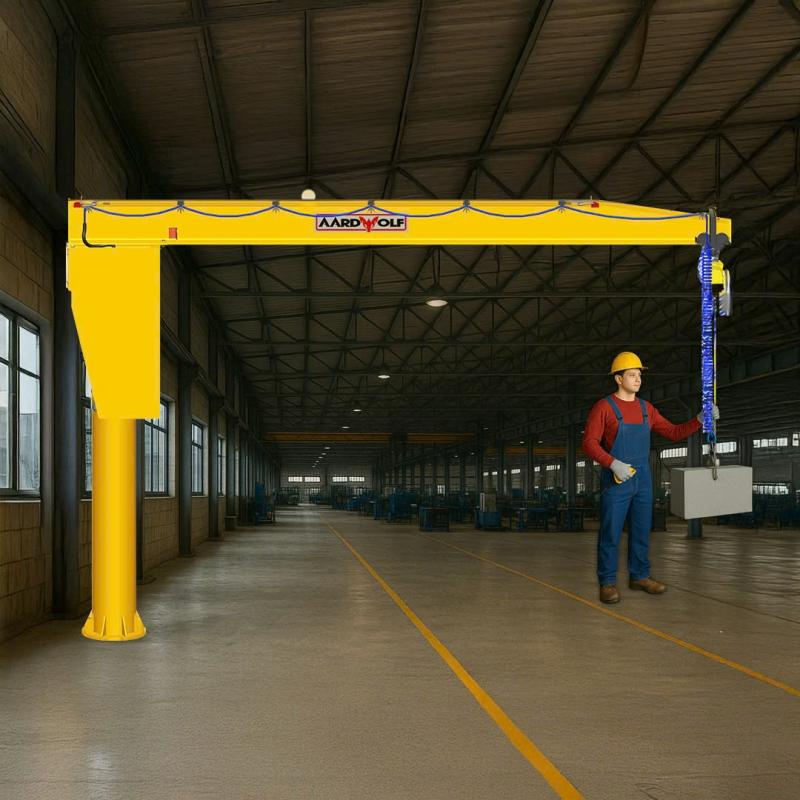
Among the myriad of options available, jib cranes stand out for their versatility and efficiency. This comprehensive guide delves into the different types of jib cranes, their specifications, installation processes, and how they compare to alternative lifting solutions.
Understanding Jib Cranes
A jib crane is a type of crane where a horizontal arm (jib or boom) supports a movable hoist, fixed to a wall or floor-mounted pillar. They are ideal for repetitive lifting tasks in confined areas, offering a rotation range between 180° and 360°, depending on the mounting style.
For detailed specifications, refer to the Specification of Jib Cranes.
Types of Jib Cranes
1. Freestanding Jib Crane
Freestanding jib cranes are mounted on a concrete foundation, allowing 360° rotation. They are versatile and can be installed virtually anywhere, making them suitable for outdoor applications or open work areas.
2. Wall Mounted Jib Crane
Wall-mounted jib cranes are attached to a wall or column, offering up to 200° rotation. They are ideal for workstations where floor space is limited. Explore Wall-mounted Jib Cranes in Industry for practical applications.
3. Ceiling Mounted Jib Crane
Ceiling-mounted jib cranes are suspended from the ceiling, preserving floor space. They are suitable for facilities with high ceilings and require no floor support, making them ideal for areas with limited floor space.
4. Articulating Jib Crane
Articulating jib cranes feature two pivoting arms for maneuvering around obstacles. They provide additional reach and flexibility, making them suitable for complex work environments. ExploreArticulated jib cranes wall-mounted for more details.
5. Pillar Jib Crane
Pillar jib cranes are mounted on a structural column, suitable for consistent lifting zones. They offer 360° rotation and are ideal for heavy-duty applications.
Comparing Jib Cranes to Alternative Lifting Solutions
When evaluating lifting solutions, it's essential to consider how jib cranes compare to other options like gantry cranes, overhead cranes, and davit arms.
Jib Crane vs. Gantry Crane
Mobility: Gantry cranes are mobile and can span larger areas, suitable for moving heavy loads across distances. Jib cranes, in contrast, are best for repetitive lifting in defined work zones.
Installation: Gantry cranes require a flat surface but no permanent installation. Jib cranes (especially freestanding and wall-mounted) need bolting or welding into place.
Cost: Jib cranes are more cost-effective for workstations. Gantry cranes tend to be more expensive but offer greater range.
Jib Crane vs. Overhead Crane
Coverage Area: Jib cranes cover a circular area, while overhead cranes cover a rectangular area. Choose based on your workspace layout and lifting needs
Load Capacity: If you need to lift heavy loads, an overhead crane is likely the better choice due to its higher capacity options.
Cost: Jib cranes are generally less expensive than overhead cranes, making them a cost-effective solution for lighter loads and localized lifting needs.
Jib Crane vs. Davit Arm
Flexibility: Davit arms are lightweight, portable lifting devices with a fixed or adjustable boom, commonly used for lifting materials over edges or into confined spaces. They are suitable for light-duty applications and offer limited rotation.
Load Capacity: Jib cranes handle higher capacities with broader coverage and are more rugged for industrial use.
Installation of Jib Cranes
Proper installation is critical to ensure the safe and efficient operation of a jib crane. Key steps include:
Site Preparation: Assess the installation area for structural integrity and space constraints.
Foundation Work: Ensure the foundation can support the crane's load capacity.
Mounting: Secure the crane to the appropriate structure (floor, wall, or ceiling).
Testing: Conduct load tests to verify performance.
For a comprehensive guide, refer to the Step by step guide to install a jib crane.
Conclusion
When operational efficiency, safety, and flexibility are key, jib cranes offer superior performance over hoists and davit arms in most industrial applications. From freestanding units on warehouse floors to wall-mounted cranes in tight workshops, Aardwolf delivers a complete lineup tailored to the demands of modern manufacturing and logistics environments.
Explore available Specifications of Jib Cranes and learn more about Manufacturing Jib Crane to make an informed purchase.
References
1. How to operate a Jib Cranes safely
3. Over brace jib crane wall mounted
5. Is a Jib Crane a Gantry Crane
6. Articulated Jib Crane Wall Mounted
8. Manual Counterbalance Crane
10. Over Braced Jib Crane Column Mounted
11. Powered counterbalance Crane
